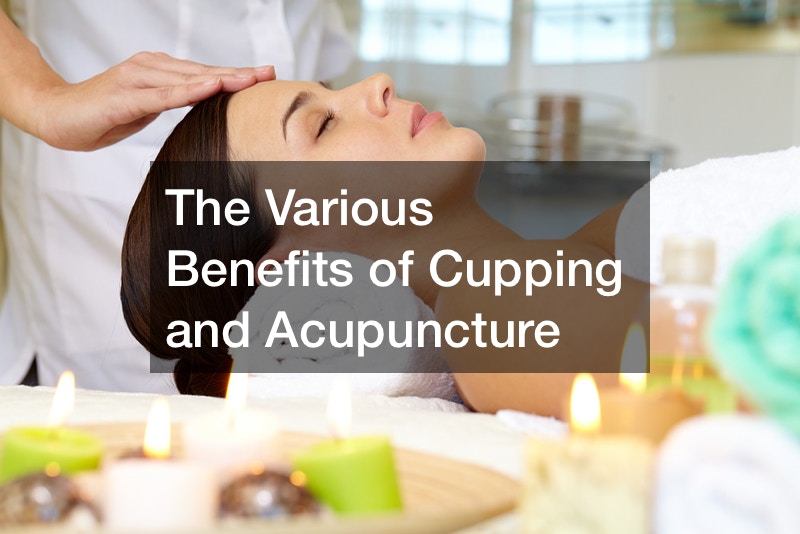
Alternative methods of healing and therapy such as acupuncturist service are fast becoming popular. Many people now prefer alternative urgent medical care compared to traditional Western medicine. You may be wondering about what cupping and acupuncture entail if you are seeking acupuncture or cupping services. The following can assist you in choosing which technique is ideal for you and also inform you about the various benefits of cupping and acupuncture.
The Origin Of Cupping and Acupuncture Therapy

Ancient China is where acupuncture and cupping therapies originated from. Acupuncture invented approximately 8,000 years ago, dates its foundations to dadaist theisms. Alternatively, cupping therapy was developed approximately 3,000 years ago. The foundation of traditional Chinese medicine follows the belief that a person’s body contains natural energy that courses through it. If this energy continues coursing through your body, then it means you are healthy. Traditional belief maintains that channels are known as “meridians” direct this energy’s flow. Illness and injury may cause a disruption to this flow and cause you to become sick.
How These Treatments Help You To Heal

Cupping and Acupuncture therapies eliminate blockages to make sure your energy flows again. With acupuncture, needles get inserted around meridian points which cause you illness or pain in your body. The acupuncturist’s main goal when performing this procedure is to attract the seamless flow of blood to these areas as blood brings nutrients and oxygen to heal illness and repair tissue damages. The area receiving treatment gets cleansed by the lymph flow that carries away waste, toxins, and other debris. Because it is done using needles, most patients undergoing acupuncture therapy report feeling minimal pain as the needles get inserted. A needle gets inserted during the therapy session or it may involve a mild electric current being applied while others say it leaves them feeling relaxed.
Improper placement of the needle during treatment may cause pain to the patient. Needles should be sterilized to prevent infection from occurring. It is why you are advised to seek acupuncture treatment from a qualified specialist. The FDA is in charge of regulating acupuncture needles just as it regulates other medical devices under acceptable manufacturing practice and single- standards of quality on sterility. Instead of using needles, other forms of stimulation are used over acupuncture points. They include:
- Impulses of electromagnetic pulses
- Suction(cupping)
- Friction
- Pressure(acupressure)
- Heat (moxibustion)
What Is The Effect Of Acupuncture To The Body?
Acupuncture points are associated with stimulating the body’s nervous system. This releases chemicals into the brain, cord, spinal and muscles. These biochemical changes are beneficial in stimulating the body’s natural healing abilities and help promote emotional and physical well-being. Acupuncture on its own or with a combination of other conventional therapies can be effective in treating the following:
- Asthma
- Carpal tunnel syndrome
- Lower back pain
- Osteoarthritis
- Myofascial pain
- Fibromyalgia
- Tennis elbow
- Menstrual cramps
- Headaches
- Addiction
- Dental pain after surgery
- Nausea caused by surgical anesthesia
- Cancer chemotherapy
It is also helpful in treating patients suffering from a stroke.
What Conditions Can Benefit From Acupuncture?

Many people seek acupuncture treatment to relieve chronic pain such as lower back pain or rotator cuff pain treatment. Before you consider acupuncture treatment, you should consult your doctor. Conditions that may benefit from acupuncture include prostatitis, addiction, impotence, bronchitis, stroke, Parkinson’s disease, muscle pain and weakness, muscle cramping, back pain, anxiety, insomnia, and hepatitis. These are some of the benefits of cupping and acupuncture.
Considerations When Choosing Acupuncture Treatment

Because acupuncture treatment can’t be fully explained within the framework of Western medicine, it still remains a source of controversy. It is important to take necessary precautions when thinking about choosing acupuncture treatment and also consider the various benefits of cupping and acupuncture.
-
Consult with Your Doctor First Before Opting for Acupuncture
Acupuncture is not an ideal treatment for every patient. Discuss the medicines and treatment including over-the-counter drugs, prescription, and dietary supplements. If you have breast or other implants, are pregnant, have chronic skin issues, are at risk of infection, or have general wellness and health if you choose not to mention these matters to your doctor.
-
Don’t Depend on a Diagnosis of Illness Provided by an Acupuncture Specialist
If you get a diagnosis from a medical practitioner, you may seek advice from them on whether acupuncture treatment is a suitable option for you.
-
Choose an Acupuncture Practitioner Who Has a License
You can ask your doctor for referrals to certified or licensed acupuncture practitioners. Family and friends can also be reliable sources of ideal referrals.
-
Consider the Insurance Coverage and Costs You Will Spend on Acupuncture Treatment
Before commencing the treatment ask your acupuncturist about the number of acupuncture treatments you will need as well as how much it will cost. Some insurance companies cover the costs of acupuncture treatment while others don’t. It is important you know these details before you start your acupuncture treatment.
Cupping
Cupping is mainly used in the creation of suction on the skin above tissue damage. This suction is also responsible for bringing blood to the treated area and heals it by taking waste away through lymph flow. Cupping is an ancient form of therapy in alternative medicine where a therapist puts special cups on your skin for some time. Many people choose to get cupping therapy for a number of reasons including well-being and relaxation, blood flow, inflammation, and help with pain as a kind of deep-tissue massage. These special cups can be made out of:
- Silicone
- Earthenware
- Bamboo
- Glass
Types of Cupping Therapy
There are different methods used in cupping, they include: wet and dry. In both types of Cupping procedures, a therapist puts flammable substances like paper a cup, herbs, and alcohol, then sets them aflame. As the fire dies down, they place the cup upside down on your skin. As the air inside the cup starts to cool down, a vacuum gets created. The cup is then left in place for about three minutes. A modern version of cupping therapy is the usage of a rubber pump instead of a fire to create a vacuum inside the cup. Other times, therapists use silicone cups, which get moved from place to place on your skin for a massage procedure. A mild suction is created when wet cupping is put in place for about three minutes. After the time lapses, the therapist removes the cup and then uses a small scalpel to make tiny, light cuts on a person’s skin. They then do a second suction that draws out a small amount of blood. Cupping therapy can be effective for people seeking alternative treatments such as acupuncture to treat various conditions and diseases like:
- Cervical spondylosis
- Facial paralysis
- Acne
- Herpes zoster
- Varicose veins
- Anxiety and depression
- High blood pressure
- Skin issues and conditions
- Gynecological and fertility disorders
- Rheumatic conditions such as arthritis
- Blood disorders like hemophilia and anemia
What To Ask Your Doctor First
Consult your doctor before starting cupping or other types of complementary or alternative medicine. Talk extensively with the cupping therapist before your procedure. Ask them:
- Are there reasons you should not get cupping?
- Are you already getting standard treatments for my condition?
- What conditions do they use cupping for?
How Cupping Therapy Is Performed
Cupping Therapy uses small cups made of glass, bamboo, animal horns, or wood. A cupping therapist might use silicone cups or medical-grade glass to watch your skin’s condition. Sterilizing these materials is also easy, which makes them coon in cupping therapy. The therapist can choose to heat the cups before they apply them to a patient’s skin. Suction then gets created over points that are in need of treatment. There are different types of Cupping therapy you can choose from. Dry cupping mainly focuses on vacuuming only, while massage cupping entails applying essential oils on a person’s skin underneath the cups after some minutes of suction. This method draws some blood up into the cup due to the suction. When the cups get removed, bandages and an antiseptic ointment are applied to the skin for the cuts to heal.
How Acupuncture Treatment Is Performed
In acupuncture therapy, small thin needles are placed at specific points on a person’s body. Choosing the services of a licensed acupuncturist means they are knowledgeable about human anatomy and the meridians. With this knowledge and years of experience practicing in this field, an acupuncturist places needles in stagnated areas using precision. When blood flows through these areas, you should feel a reduction in stress where the needles got placed.
Using a combination of Acupuncture and Cupping Therapy
Some types of health conditions can cause a therapist to recommend both acupuncture and cupping. Needles are applied first, then the cups are placed to create a suction. The combined benefits of both types of therapies help to promote quick blood flow and healing in your body.
Medical Conditions These Therapies Help To Heal
Acupuncture and cupping therapy help with various medical conditions. These include lymphatic system boosting, bronchitis, colds, flu, musculoskeletal pain, physical injuries, depression, anxiety, poor digestion, and skin health. You should consult with your doctor before you receive any of these therapies, especially if you have a blood disorder or are pregnant.
Similarities Between Acupuncture and Cupping Therapies
- Both practices trace their origins to Asia. Egyptian and Chinese medical transcripts
dating back to the B.C era contain entries detailing out these treatments and procedures
- Both treatments take a duration of 10-30 minutes to complete
- Patients who try their hand at acupuncture and cupping hope to find relief from depression, high blood pressure, and migraines.
Differences Between Cupping and Acupuncture
- Cupping therapy mainly uses treatment materials on the surface of a person’s skin while acupuncture uses needles to insert into a patient’s skin. While the needle services are small in size and are hardly sensed by a patient when inserted, they are applied at different depths to identify areas that can benefit from the treatment
- Acupuncture can incorporate the usage of electric pulses to help with the treatment procedure
- Cupping therapy is still working to establish itself as an alternative treatment option, many doctors with acupuncture backgrounds advise their patients to combine acupuncture and cupping therapy to get effective treatment
You should choose whichever treatment you find suitable to your liking and one that will benefit you and heal you from your illness. A good way of finding ideal acupuncture and cupping therapy specialists is by consulting with your doctor who will guide you in getting a legit ear examination and alternative physical therapy treatments. They will also refer you to the best facilities offering acupuncture and cupping therapies.
Aside from this, you should also arm yourself with a reliable disability lawyer in case issues arise from your treatment. Glaucoma treatment also stands a chance to benefit from these alternative treatments. It is also important to do your own research before deciding to opt for various alternative methods of treatment and learn about the various benefits of cupping and acupuncture. This will ensure that you get the best results and also prevent you from falling for scams.
Acupuncture and cupping may differ in a variety of approaches but they serve similar purposes. Finding a reliable practitioner in these fields ensures that you will get optimal results during your treatments.
You can also use the internet as a reliable source of information on alternative treatments and learn more about acupuncture treatment and cupping therapy. Make sure to read through the various benefits of cupping and acupuncture treatments before choosing one that is ideal for you. This will ensure you get the best out of the various benefits of cupping and acupuncture should you choose one or both of them. Medical practitioners can also recommend which treatment or throat doctor is ideal for you and can help you with your illness.
If you wish to learn more about acupuncture and cupping therapies, give us a call today. We offer acupuncture and cupping therapies performed by certified and qualified therapists to patients seeking alternative treatments.



